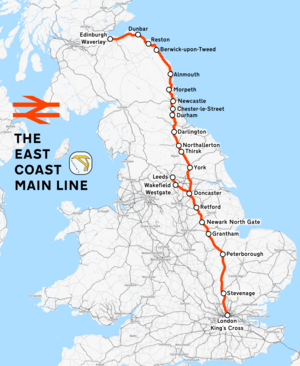
Back East Coast Main Line Afrikaans পূর্ব উপকূলীয় প্রধান রেলপথ Bengali/Bangla East Coast Main Line Danish East Coast Main Line German East Coast Main Line Estonian خط اصلی ساحل شرقی Persian East Coast Main Line French East Coast Main Line Italian イースト・コースト本線 Japanese East Coast Main Line Dutch
| East Coast Main Line | |||
|---|---|---|---|
 | |||
| Overview | |||
| Status | Operational | ||
| Owner | Network Rail | ||
| Locale | |||
| Termini | |||
| Stations | 52 | ||
| Service | |||
| Type | |||
| System | National Rail | ||
| Operator(s) | |||
| Depot(s) |
| ||
| History | |||
| Opened | 1850 | ||
| Technical | |||
| Line length | 393 mi 13 chains (632.7 km)[1] | ||
| Number of tracks | Double and quadruple track | ||
| Character | Primary[2] | ||
| Track gauge | 1,435 mm (4 ft 8+1⁄2 in) standard gauge | ||
| Loading gauge | W9 (via Hertford Loop) | ||
| Route availability | RA 7–9, RA 10 in parts between Selby and York | ||
| Electrification | 25 kV 50 Hz AC OLE | ||
| Operating speed | 125 mph (200 km/h)[a] | ||
| |||
The East Coast Main Line (ECML) is a 393-mile long (632 km) electrified railway between its northern terminus at Edinburgh Waverley and southern terminus at London King's Cross station. The key towns and cities of Peterborough, Doncaster, York, Darlington, Durham and Newcastle are on the line. The line is a key transport artery on the eastern side of Great Britain running broadly parallel to the A1 road. The main line acts as a 'spine' for several diverging branches, serving destinations such as Cambridge, Leeds, Hull, Sunderland and Lincoln, all with direct services to London. In addition, a few ECML services extend beyond Edinburgh to serve other Scottish destinations, such as Stirling, Inverness, Aberdeen or Glasgow Central, although the principal London-Glasgow route is the West Coast Main Line (WCML).
The line was built during the 1840s by three railway companies, the North British Railway, the North Eastern Railway, and the Great Northern Railway. In 1923, the Railways Act 1921 led to their amalgamation to form the London and North Eastern Railway (LNER) and the line became its primary route. The LNER competed with the London, Midland and Scottish Railway (LMS) for long-distance passenger traffic between London and Scotland. The LNER's chief mechanical engineer Nigel Gresley designed iconic Pacific steam locomotives including Flying Scotsman and Mallard, the latter of which achieved a world record speed for a steam locomotive, 126 mph (203 km/h) on the Grantham-to-Peterborough section.
In 1948, the railways were nationalised and operated by British Railways. In the early 1960s, steam was replaced by diesel-electric traction, including the Deltics, and sections of the line were upgraded so that trains could run at speeds of up to 100 mph (160 km/h). With the demand for higher speed, British Rail introduced InterCity 125 high-speed trains between 1976 and 1981. In 1973, a Class 41 (an HST prototype) achieved a top speed of 143 mph (230 km/h) in a test run. In the 1980s, the line was electrified and InterCity 225 trains introduced. These have in turn been largely replaced by Class 800 and Class 801 units. The November 2021 Integrated Rail Plan for the North and Midlands stated that the linespeed would be upgraded to 140 mph (225 km/h).
The line links London, South East England, East Anglia and the East Midlands, with Yorkshire, the North East and Scotland, and is important to their local economies. It carries commuter traffic in north London as well as cross-country, commuter and local passenger services, and freight. In 1997, operations were privatised. The primary long-distance operator is London North Eastern Railway, but open-access competition on services to Northern England and Scotland is provided by Hull Trains, Grand Central and Lumo.
- ^ "East Coast Main Line Rail Route Upgrading, United Kingdom". Archived from the original on 11 June 2017. Retrieved 13 January 2009.
- ^ "Route 5 – West Anglia" (PDF). Network Rail. Archived from the original (PDF) on 7 June 2011. Retrieved 22 May 2009.
Cite error: There are <ref group=lower-alpha> tags or {{efn}} templates on this page, but the references will not show without a {{reflist|group=lower-alpha}} template or {{notelist}} template (see the help page).
